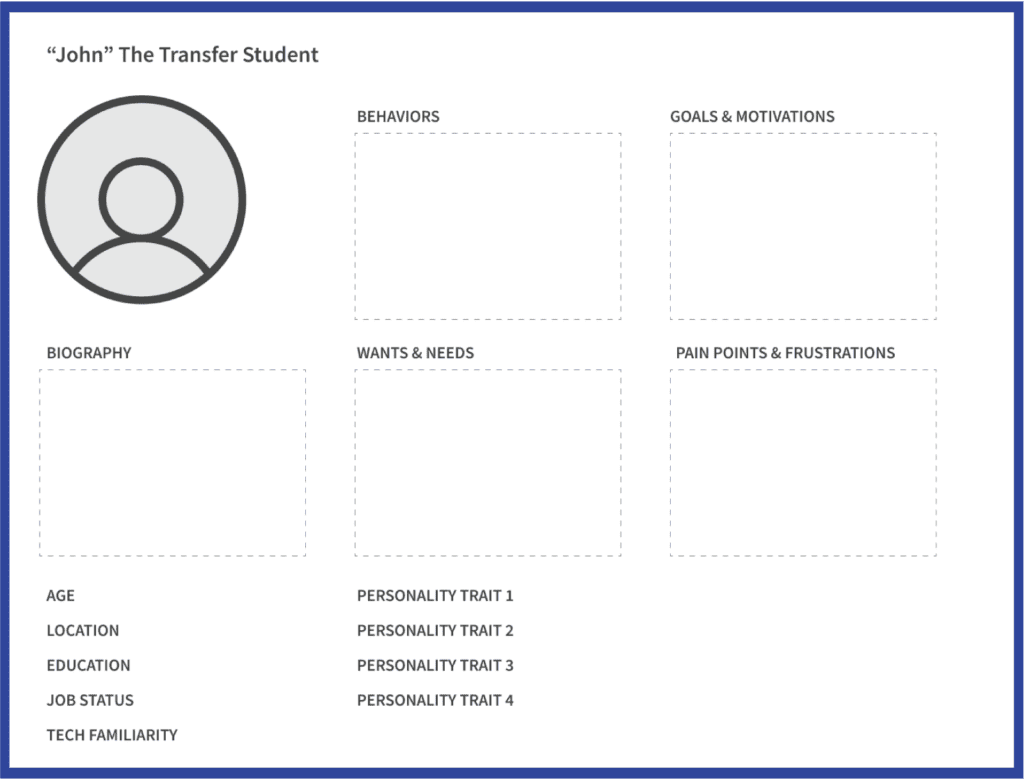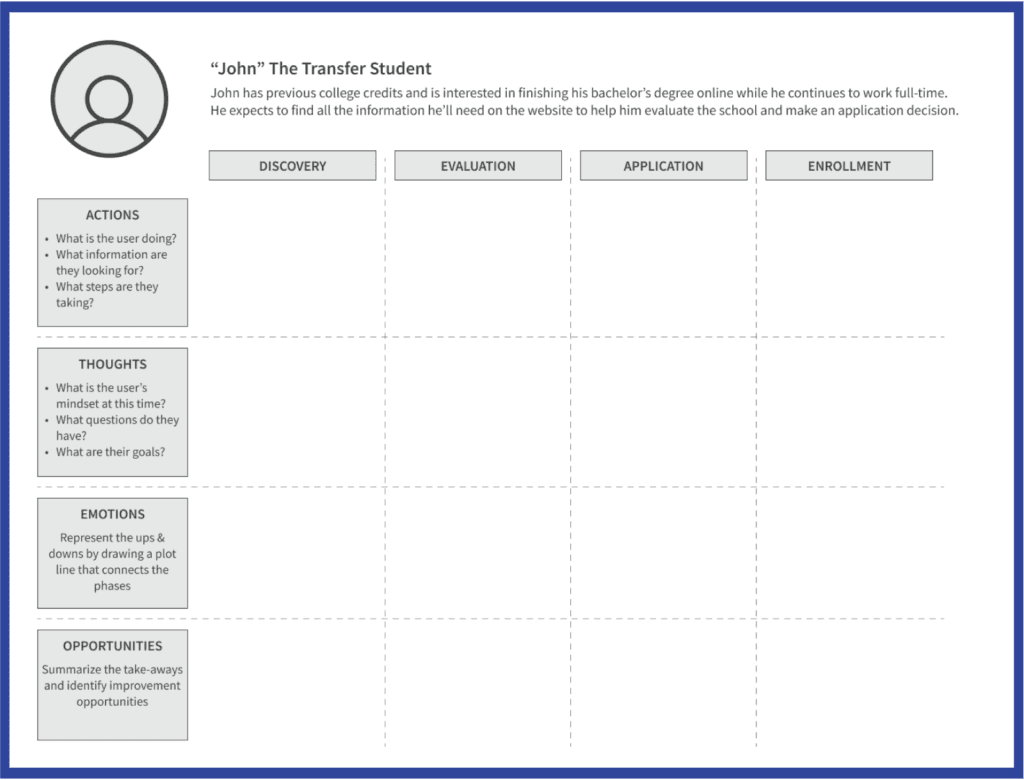How Can UX Boost Higher Ed Enrollment?
User experience (UX) design is the multifaceted process of defining how users interact with your website. It requires you to get to know your user to determine what journey you can create to meet their unique needs.
Investing in UX early on as part of your higher ed marketing strategy will allow you to deliver a curated experience that garners value. The sooner you begin, the sooner you can adapt and optimize the design to drive more meaningful and useful experiences.
What Is UX?
User experience refers to the sum of prospective students’ experiences as they navigate the journey you create for them on your website. Peter Morville’s “UX honeycomb” defines the key attributes of valuable information as: useful, usable, desirable, findable, accessible, and credible. Many UX designers consider this honeycomb their north star as they design and iterate. UX design requires getting to know your prospective audience by homing in on what these attributes look like to them. You need to keep these factors top of mind when testing and building a brand experience.
Discover the Role of UX on Your Website
Websites can provide many opportunities to connect with potential students and are often the first touch point or experience along a student’s journey. They allow brands like yours to make a good first impression and build trust not only through an attractive user interface (UI) but with a total user-centric experience that meets the needs of your prospective students. This is accomplished by prioritizing their expectations and showing up with your brand differentiators. Your values should be represented in your website’s UX and UI, reinforcing who you are and what you care about.
Win Without a UX Team
Not all brands have the ability to hire UX developers right off the bat. Still, those on your marketing and enrollment teams can do a few exercises to dive deeper into your prospective students’ needs and expectations, beyond standard data analytics practices.
- First, you can empathize with students through persona development. This should help you pinpoint how to best cater to them while addressing their potential pain points.
- Next, you can visualize their student journey from top to bottom, creating a student journey map that paints a picture of each step of their brand experience.
Develop Personas to Build a More Thoughtful UX
Personas are fictional representations of your most common users with similar attitudes and goals. They should reflect your prospective students and essentially make up the target audience you’re building these experiences for.
Persona development should start with conversations among a few of your main audience groups, such as transfer students, military students, first-time freshmen, etc. Identify three to four students from each group who are willing to share a bit about their behavior, motivations, and frustrations when they embarked on their student journeys.
Interview Students With Key Questions
Ask open-ended questions and try your best to get authentic responses to ensure you’re hearing about a broad spectrum of experiences. You can start with questions like:
- What was your biggest motivation for applying to the college/university?
- How much time did you spend researching schools before deciding to apply?
- What was your biggest deciding factor when choosing a college/university?
- What was the hardest part about applying?
- If you had a magic wand, is there anything you would change about the application process?
If you’re unable to bring in actual students, you can always tap the teams who know them best to answer your questions. Consider inviting admissions and student success teams, who work very closely with students and can accurately represent them through anecdotes and descriptions of their in-field experiences.
Create a Working Biography
After your discussions, you should be able to review the responses holistically and identify common themes and patterns that you can begin prioritizing. Organize the information into key categories like behavior, goals, desires, and frustrations. With all of this in mind, you should be able to create a working “biography” that represents your new persona.

This biography should include not only the key factors mentioned above but also demographic data, background information, and relevant context. These details can be anything from tech familiarity and family status to personality traits and geographic location. Paint a vivid picture for your team to help humanize these prospects.
Utilize Personas to Create the Most Effective UX
By building out this biography, you’re creating a persona for the team to keep in mind when making website strategy decisions. Take some steps to ensure this biography is utilized as often as possible:
- Help team members get to know this persona and refer to them by a name, such as Joe.
- Brainstorm how you can meet this persona’s unique needs and address any potential frustrations they may have during enrollment.
- Address any low-hanging fruit that could optimize this persona’s experience in the short term.
The more you talk about this persona and measure your decisions against their potential point of view, the more you’ll prioritize them over other users. Their needs, desires, and behaviors should be king. They should be represented in every single user experience optimization, for example: Would Joe appreciate this? Am I solving any of Joe’s problems or eliminating Joe’s roadblocks? How am I meeting Joe’s unique needs with this project? Eventually, it will feel like this fictional character — along with any other key prospect personas — is in every UX meeting you have.
Incorporate UX into the Student Journey
Nielsen Norman Group defines a journey map as “a visualization of the process that a person goes through in order to accomplish a goal.” By laying out each step in the student journey, your team can zero in on insights and identify areas for opportunity.
Create a Student Journey Map for Higher Impact
Now that you have a persona, you can begin by creating a user scenario for them. There are plenty of directions you can go, but consider some key experiences from those earlier conversations. For example: Someone with previous college credits is interested in pursuing a bachelor’s degree online while they continue to work full time. Their expectation is to find all the information they’ll need on the website to help them make a decision and apply.
With this in mind, map out each step of the journey horizontally: discovery, evaluation, application, enrollment, retention, and advocacy. Then, add actions, thoughts, mindsets, and emotions vertically.

Think critically here. What might the user do? What are they thinking about while doing it? What information are they actively seeking? What’s motivating them to be here? Where are opportunities to delight them? Where might they get frustrated?
Once you’ve explored both directions of the map and how they work together, summarize key takeaways from each step and tighten your experience to cater more directly to your most frequent users.
Put the User First for Higher Enrollment Rates
Putting the user first and listening to their needs can help build trust early on, growing positive brand perceptions and ultimately increasing engagement rates and enrollment rates. Taking the time to create UX research artifacts like personas and student journey maps can help your team get a more comprehensive understanding of how your UX should work and who it should work for. Through this development, you’ll get smarter about what your audience needs and how to deliver on those needs. Archer Education partners with dozens of institutions to help them overcome enrollment challenges using tech-enabled, personalized enrollment marketing and management solutions. Click here to request more information about Archer’s full-funnel engagement strategies and digital student experience technology.
Sources:
